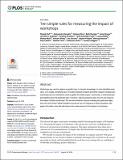Files in this item
Ten simple rules for measuring the impact of workshops
Item metadata
| dc.contributor.author | Sufi, Shoaib | |
| dc.contributor.author | Nenadic, Aleksandra | |
| dc.contributor.author | Silva, Raniere | |
| dc.contributor.author | Duckles, Beth | |
| dc.contributor.author | Simera, Iveta | |
| dc.contributor.author | de Beyer, Jennifer A. | |
| dc.contributor.author | Struthers, Caroline | |
| dc.contributor.author | Nurmikko-Fuller, Terhi | |
| dc.contributor.author | Bellis, Louisa | |
| dc.contributor.author | Miah, Wadud | |
| dc.contributor.author | Wilde, Adriana | |
| dc.contributor.author | Emsley, Iain | |
| dc.contributor.author | Philippe, Olivier | |
| dc.contributor.author | Balzano, Melissa | |
| dc.contributor.author | Coelho, Sara | |
| dc.contributor.author | Ford, Heather | |
| dc.contributor.author | Jones, Catherine | |
| dc.contributor.author | Higgins, Vanessa | |
| dc.date.accessioned | 2018-08-31T11:30:05Z | |
| dc.date.available | 2018-08-31T11:30:05Z | |
| dc.date.issued | 2018-08-30 | |
| dc.identifier | 253048692 | |
| dc.identifier | 27106cd1-6d43-4169-a059-ee912d310c4b | |
| dc.identifier | 85059248931 | |
| dc.identifier.citation | Sufi , S , Nenadic , A , Silva , R , Duckles , B , Simera , I , de Beyer , J A , Struthers , C , Nurmikko-Fuller , T , Bellis , L , Miah , W , Wilde , A , Emsley , I , Philippe , O , Balzano , M , Coelho , S , Ford , H , Jones , C & Higgins , V 2018 , ' Ten simple rules for measuring the impact of workshops ' , PLoS Computational Biology , vol. 14 , no. 8 , e1006191 . https://doi.org/10.1371/journal.pcbi.1006191 | en |
| dc.identifier.issn | 1553-734X | |
| dc.identifier.uri | https://hdl.handle.net/10023/15919 | |
| dc.description | SS, AN, RS, IE, and OP acknowledge the support of EPSRC, BBSRC and ESRC Grant EP/N006410/1 for the UK Software Sustainability Institute, http://gow.epsrc.ac.uk/NGBOViewGrant.aspx?GrantRef=EP/N006410/1. IS, CS, and JdB acknowledges support from Cancer Research UK (grant C5529/A16895). | en |
| dc.description.abstract | Workshops are used to explore a specific topic, transfer knowledge, solve identified problems or create something new. In funded research projects and other research endeavours, workshops are the mechanism to gather the wider project, community or interested people together around a particular topic. However, natural questions arise: how do we measure the impact of these workshops? Do we know whether they are meeting the goals and objectives we set for them? What indicators should we use? In response to these questions, this paper will outline rules that will improve the measurement of the impact of workshops. | |
| dc.format.extent | 12 | |
| dc.format.extent | 474385 | |
| dc.language.iso | eng | |
| dc.relation.ispartof | PLoS Computational Biology | en |
| dc.rights | Copyright: © 2018 Sufi et al. This is an open access article distributed under the terms of the Creative Commons Attribution License, which permits unrestricted use, distribution, and reproduction in any medium, provided the original author and source are credited. | en |
| dc.subject | LB2300 Higher Education | en |
| dc.subject | QA76 Computer software | en |
| dc.subject | T-NDAS | en |
| dc.subject.lcc | LB2300 | en |
| dc.subject.lcc | QA76 | en |
| dc.title | Ten simple rules for measuring the impact of workshops | en |
| dc.type | Journal item | en |
| dc.contributor.institution | University of St Andrews.School of Computer Science | en |
| dc.identifier.doi | 10.1371/journal.pcbi.1006191 | |
| dc.description.status | Peer reviewed | en |
| dc.identifier.url | https://arxiv.org/abs/1805.03522v1 | en |
This item appears in the following Collection(s)
Items in the St Andrews Research Repository are protected by copyright, with all rights reserved, unless otherwise indicated.

